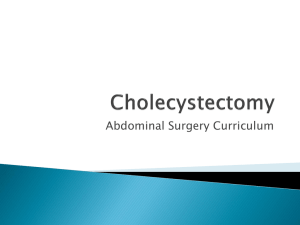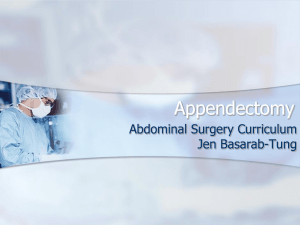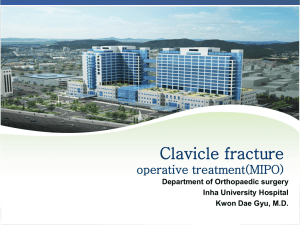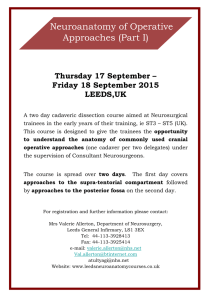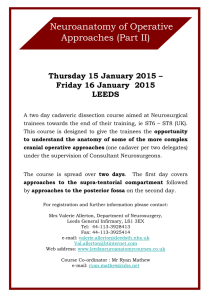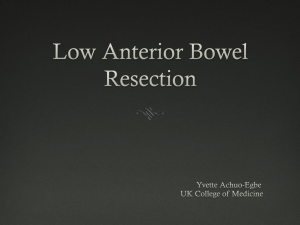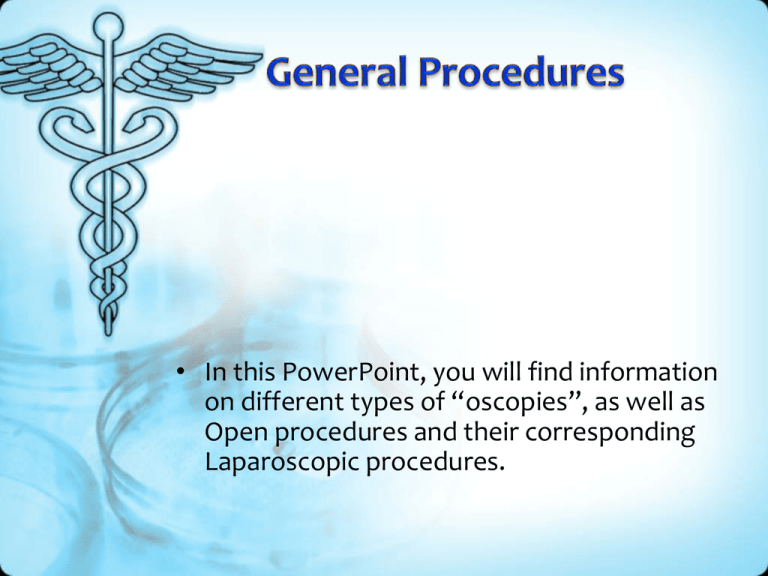
• In this PowerPoint, you will find information
on different types of “oscopies”, as well as
Open procedures and their corresponding
Laparoscopic procedures.
Sigmoidoscopy
Colonoscopy
ERCP
Choledochoscopy
Esophagoscopy
EGD
Sigmoidoscopy
Flexible or rigid scopes
are used.
Used to evaluate
conditions of the
rectum.
IV sedation is
recommended.
Colonoscopy
A procedure done to
check for abnormalities
in the colon.
Done under IV sedation
Biopsies, pictures, and
brushings can be taken
through endoscope.
ERCP
(Endoscopic Retrograde Cholangiopancreatography)
Used in visualization of the soft tissues and sphincter fibers of the papilla
and intraduodenal duct.
Can lead to ERS, Endoscopic Retrograde Sphincterotomy, which permit
stones to move into the duodenum.
Choledochoscopy
Visualization of the gallbladder, cystic duct and common bile
duct using a scope.
Esophagoscopy
Performed on the
esophagus.
Used to evaluate pain or
dysphagia (painful
swallowing).
Can be used for foreign body
removal, hemostasis,
dilation, and biopsies.
Not to be confused with an
EGD
(Esophagogastroduodenoscopy)
Esophagogastroduodenoscopy.
A diagnostic endoscopic procedure
that visualizes the upper part of the
gastrointestinal tract up to the
duodenum.
Old EGD Fast
GI Open Procedures
Operative Sequence
Laparotomy
Laparotomy
• Overall Purpose of Procedure:
• An Exploratory Laparotomy is
performed to examine he abdominal
cavity when less invasive measures,
such as x-rays and CT scans, fail to
confirm a diagnosis.
• Case length – 30 mins to many hours.
Laparotomy
• Define the procedure:
• Abdominal exploration may be used to help diagnose
many diseases and health problems, including:
• Inflammation of the appendix (acute appendicitis)
• Inflammation of the pancreas (acute or chronic
pancreatitis)
• Pockets of infection (retroperitoneal abscess, abdominal
abscess, pelvic abscess)
• Endometriosis
• Inflammation of the fallopian tubes (salpingitis)
• Scar tissue in the abdomen (adhesions)
• Cancer of the ovary, colon, pancreas, liver
Laparotomy
•
•
•
•
Inflammation of an intestinal pocket (diverticulitis)
Hole in the intestine (intestinal perforation)
Pregnancy outside of the uterus (ectopic pregnancy)
This surgery may also be used to determine the extent of
certain cancers, such as Hodgkin's lymphoma (also
known as Hodgkin's disease, a type of lymphoma
characterized clinically by the orderly spread of disease
from one lymph node group to another and by the
development of systemic symptoms with advanced
disease.)
• Wound Classification: 1 (yet depends on
what you do during the case)
Operative Sequence
•
•
•
•
•
•
•
•
•
1- Incision
2- Hemostasis
3- Dissection
4- Exposure
5- Procedure (Specimen Collection possible)
6- Hemostasis
7- Irrigation
8- Closure
9- Dressing Application
Laparotomy
• Instrumentation: Major/Minor Instrument Tray.
• What basic instruments will you expect to see in this
tray?
• Positioning: The patient is in supine position, arms
tucked at the side or on arm boards. Surgeon stands
on the left side of the patient.
• Prepping: Surgeon preference. Duraprep, Hibiclense
or a Betadine Prep Kit. Prep from midchest to groin
area and far lateral on both sides.
• Draping: Standard draping procedure. 4 towels and
a lap drape. Ask about towel clips.
Laparotomy
Begin your Operative Sequence
• Incision: 10 kb
on #3 handle for
incision.
• A midline
abdominal
incision is made.
Laparotomy
cont. Operative Sequence
• Hemostasis: Handheld Bovie, hemostats,
free ties or clips are utilized.
Laparotomy
cont. Operative Sequence
• Dissection and
Exposure:
• Army-Navys
• Richardsons
• Balfour
• Bookwalter
Laparotomy
cont. Operative Sequence
• Exploration and Isolation:
• This entire step will depend on what
procedure is needed!
• Surgical
Repair/Removal/Specimen
Collection:
• This entire step will depend on what
procedure is needed!
Laparotomy
cont. Operative Sequence
• Hemostasis and Irrigation:
• All bleeding is controlled with cautery.
• Use of warm Saline to irrigate.
Laparotomy
cont. Operative Sequence
• Closure:
• Will use strong suture for peritoneal
layer such as 0 looped PDS.
• Will use a 0-Vicryl to close the
fascial/muscle layer and a 4-0
Monocryl for skin.
• Skin staples are always an option.
Laparotomy
• Major Arteries:
•
•
•
•
•
•
•
Internal thoracic artery
The superior epigastric artery
Aorta
External iliac artery: the inferior
epigastric and deep circumflex
arteries
Inferior phrenic artery, branch
of the abdominal aorta.
Lower posterior intercostal and
subcostal arteries, branches of
thoracic aorta.
Lumbar arteries, from
abdominal aorta.
GI Laparoscopic Procedures
Operative Sequence
Laparoscopic Appendectomy
Laparoscopic Appendectomy
• Overall Purpose of Procedure:
• Appendectomies are performed to treat appendicitis, an inflamed
and/or infected appendix. An infected appendix can leak and infect
the entire abdominal area, which can be deadly.
• An irritated appendix can rapidly turn into an infected and
ruptured appendix, sometimes within hours. A ruptured
appendix can be life threatening. When the appendix
ruptures, bacteria infect the organs inside the abdominal
cavity, causing peritonitis. The bacterial infection can spread
very quickly and be difficult to treat if diagnosis is delayed.
Laparoscopic Appendectomy
• Define the procedure: Removal of the
appendix with the aid of a laparoscope.
• Wound Classification: 2 if not ruptured
and no spillage of bowel contents during
procedure.
• Case length – 30 mins to 1hour.
Operative Sequence
•
•
•
•
•
•
•
•
•
1- Incision
2- Hemostasis
3- Dissection
4- Exposure
5- Procedure (Specimen Collection possible)
6- Hemostasis
7- Irrigation
8- Closure
9- Dressing Application
Laparoscopic Appendectomy
• Instrumentation: Laparoscopic Instrument Tray.
• What other basic instruments will you expect to see in this tray?
• Positioning: The patient is in supine position, arms tucked at the side.
Surgeon stands on the left side of the patient with the camera
holder/assistant. Monitor should be placed near right hip facing
towards surgeon. Trendelenburg? WHY?
• Prepping: Surgeon preference. Duraprep, Hibiclense or a Betadine
Prep Kit. Prep from Chest to just above pubic hair and far lateral on
both sides. Pre-prep hair trimming might be necessary.
• Draping: Standard draping procedure. 4 towels and a lap drape. Ask
about towel clips.
Laparoscopic Appendectomy
Begin your Operative Sequence
• Incision: Two
towel clips around
umbilicus.
• 15 kb on #3 handle
for incision.
• Veres Needle and
CO-2 on high flow.
Laparoscopic Appendectomy
cont. Operative Sequence
• Hemostasis: Can be from multiple means. The
pressure of the trocars entering the
pneumoperitineum will stop most bleeding.
Bovie: either from the handheld pencil or L (or J)
Hook is also available.
Laparoscopic Appendectomy
cont. Operative Sequence
• Dissection and
Exposure:
•
•
•
•
•
Total of 3 trocars should be used
Two 10mm (umbilical and left
lower quadrant) and one 5 mm
right upper quadrant trocar
The right upper quadrant trocar
can be moved below the bikini line
in females.
Camera/scope placed into
pneumoperitineum.
In most cases, no other dissection
or exposure is needed.
Laparoscopic Appendectomy
cont. Operative Sequence
• Exploration and Isolation:
• An atraumatic grasper [Endo Babcock, Maryland,
Bowel Grasper, Dolphin Nose Grasper etc] is inserted
via the right upper quadrant trocar. The cecum (from
the Latin caecus meaning blind) is retracted upward
toward the liver. In most cases, this will elevate the
appendix in the optical field of the telescope.
• The appendix is grasped at its tip with a 5 mm bowel
grasper via the RUQ trocar. It is held in upward
position
Laparoscopic Appendectomy
cont. Operative Sequence
• Surgical Repair/Removal/Specimen Collection:
• Left lower quadrant (LLQ) grasper is used to create a mesenteric
window behind the base of the appendix. A grasper is used to
create a mesenteric window under the base of the appendix. The
window should be made as close as possible to the base of the
appendix.
• The base of the appendix is then separated from it’s cecal base
with either an endo-loop suture and scissors or a stapling device.
Visualization of the staple line is a must to insure no leakage of
bowel content and no bleeding is present.
• The mesoappendix (the portion of the mesentery connecting the
ileum to the appendix) is divided and ligated, either with cautery or
a stapling device.
• Removal of the appendix with Endo-pouch
• or Kellys/Peons
Laparoscopic Appendectomy
Laparoscopic Appendectomy
cont. Operative Sequence
• Hemostasis and Irrigation:
• The intra-abdominal cavity is irrigated thoroughly with
normal saline.
• All bleeding is controlled with a cautery-capable endoinstrument.
• The abdomen should be examined for any possible
bowel injury or hemorrhage. All the instruments and
ports should be carefully and slowly removed while the
CO-2 in the pneumoperitineum is released.
Laparoscopic Appendectomy
cont. Operative Sequence
• Closure:
• Closure will be surgeon specific. Some
Surgeons today will not close any layer other
than skin.
• Other surgeons will use a 0-Vicryl to close the
fascial/muscle layer and a 4-0 Monocryl for
skin.
• Skin staples are always an option.
Laparoscopic Appendectomy
• Major Arteries: The appendix is supplied by the
appendicular artery , branch of the ileocolic artery.
Laparoscopic Appendectomy
• Major Veins: The ileocolic vein, a tributary of the
superior mesenteric vein, drains the blood of the appendix.
• Major Nerves: The nerves of the appendix are derived from
the coeliac and superior mesenteric ganglia.
References
Sites of Interest
•
•
•
•
•
http://www.madsci.org/posts/archives/1998-02/887299251.An.r.html
http://www.laparoscopyhospital.com/Laparoscopic_Appendicectomy.doc
http://www.surgeryencyclopedia.com/A-Ce/Appendectomy.html
http://www.healthsystem.virginia.edu/UVAHealth/peds_digest/appendic.cfm
http://www.drugs.com/enc/appendectomy.html
Appy Video
• Lap Appy per EES-Edu
Open Appendectomy
• Overall Purpose of Procedure:
• Appendectomies are performed to treat appendicitis, an inflamed
and/or infected appendix. An infected appendix can leak and infect
the entire abdominal area, which can be deadly.
• An irritated appendix can rapidly turn into an infected and
ruptured appendix, sometimes within hours. A ruptured
appendix can be life threatening. When the appendix
ruptures, bacteria infect the organs inside the abdominal
cavity, causing peritonitis. The bacterial infection can spread
very quickly and be difficult to treat if diagnosis is delayed.
Open Appendectomy
• Define the procedure: Removal of the
appendix via open approach.
• Wound Classification: 2 if not ruptured
and no spillage of bowel contents during
procedure.
• Case length – 30 mins to 1.5 hours.
Operative Sequence
•
•
•
•
•
•
•
•
•
1- Incision
2- Hemostasis
3- Dissection
4- Exposure
5- Procedure (Specimen Collection possible)
6- Hemostasis
7- Irrigation
8- Closure
9- Dressing Application
Open Appendectomy
• Instrumentation: Minor/Major Instrument Tray.
• What basic instruments will you expect to see in this tray?
• Positioning: The patient is in supine position, arms tucked at the side.
Surgeon stands on the left side of the patient. Trendelenburg? WHY?
• Prepping: Surgeon preference. Duraprep, Hibiclense or a Betadine
Prep Kit. Prep from Chest to just above pubic hair and far lateral on
both sides. Pre-prep hair trimming might be necessary.
• Draping: Standard draping procedure. 4 towels and a lap drape. Ask
about towel clips.
Open Appendectomy
• Incision: McBurneys incision
Which one is
the
McBurney?
Open Appendectomy
• Hemostasis: Handheld Bovie,
hemostats, free ties or clips are
utilized.
Open Appendectomy
• Dissection and Exposure:
• Metz scissors and Debakey forceps.
• Bovie for dissection and hemostasis
• Army-Navy Ret, Small Rich or even Goulet for retraction and exposure of
surgical site.
• Possible need of Balfour Retractor in obese patients ONLY.
Open Appendectomy
• Exploration and Isolation:
• Bowel is mobilized with Babcock clamp.
• Appendix is located and brought up through the incision site.
Open Appendectomy
• Surgical Repair/Removal/Specimen Collection:
• Moist towel is placed around the base of the appendix
to keep incision site clean when “ectomy” is performed.
• Using Metz scissors, the meso-appendix is isolated.
• It is double clamped, cut and vasularity ligated with silk
ties.
• Why silk?
• Uses 2-0 or 3-0 to tie. Have suture scissors ready.
Open Appendectomy
• Surgical Repair/Removal/Specimen Collection:
• Surgeon will clamp base of the appendix with a Kelly
clamp.
• Have a heavy silk tie ready to pass around the Kelly,
possibly 2 ties.
• Surgeon will run a purse string suture around the base
of the appendix (called the “stump”).
• Why do they do this?
• Appendix is ready to be excised.
Open Appendectomy
• Surgical Repair/Removal/Specimen
Collection:
• Bring up pan (emesis basin?) to place dirty
instruments into.
• Surgeon can use Metz or 10 kb to excise
Appendix, making incision ABOVE the silk tie.
• Surgeon will pass off specimen to you.
• Surgeon will ask for Kelly clamp.
Open Appendectomy
• Surgical Repair/Removal/Specimen
Collection:
• Surgeon will grasp the remainder of the stump
with the Kelly clamp and invert the stump
INTO the Cecum.
• The purse-string suture is then
• tightened, thus burying
• the appendicle stump.
Open Appendectomy
• Surgical Repair/Removal/Specimen
Collection:
• Remember that instruments that come into
contact with the INTERIOR of bowel are
considered contaminated and need to be kept
separate form other clean/sterile instruments.
• Remove them from your immediate field and
make sure you don’t go back to them (even
when you count!).
Open Appendectomy
• Hemostasis and Irrigation:
• The intra-abdominal cavity is irrigated thoroughly with
normal saline.
• All bleeding is controlled with a cautery.
• The abdomen should be examined for any possible bowel
injury or hemorrhage.
Open Appendectomy
• Closure:
• Surgeons will use a 0-Vicryl to close the
fascial/muscle layer and a 4-0 Monocryl for
skin.
• Skin staples are always an option.
• Penrose drain might be required.
GI Laparoscopic Procedures
Operative Sequence
Laparoscopic Cholecystectomy
Laparoscopic Cholecystectomy
• Overall Purpose of Procedure:
• The surgery is usually done if the organ is inflamed or
obstructed, if gallstones are causing pancreatitis, or if cancer
is suspected.
Laparoscopic Cholecystectomy
• Define the procedure: Removal of the
gallbladder with the aid of a laparoscope.
• Wound Classification: 2
• Case length – 30 mins to 1 hour.
Operative Sequence
•
•
•
•
•
•
•
•
•
1- Incision
2- Hemostasis
3- Dissection
4- Exposure
5- Procedure (Specimen Collection possible)
6- Hemostasis
7- Irrigation
8- Closure
9- Dressing Application
Laparoscopic Cholecystectomy
• Instrumentation: Laparoscopic Instrument Tray.
• What other basic instruments will you expect to see in this tray?
• Positioning: The patient is in supine position, arms tucked at the side.
Surgeon stands on the left side of the patient with the camera
holder/assistant on opposite side of bed. Monitor should be placed near
right hip facing towards surgeon. Reverse Trendelenburg? WHY?
• Prepping: Surgeon preference. Duraprep, Hibiclense or a Betadine
Prep Kit. Prep from Chest to just above pubic hair and far lateral on
both sides. Pre-prep hair trimming might be necessary.
• Draping: Standard draping procedure. 4 towels and a lap drape. Ask
about towel clips.
Laparoscopic Cholecystectomy
Begin your Operative Sequence
• Incision: Two
towel clips around
umbilicus.
• 15 kb on #3 handle
for incision.
• Veres Needle and
CO-2 on high flow.
Laparoscopic Cholecystectomy cont.
Operative Sequence
• Hemostasis: Can be from multiple means. The
pressure of the trocars entering the
pneumoperitineum will stop most bleeding.
Bovie: either from the handheld pencil or L (or J)
Hook is also available.
Laparoscopic Cholecystectomy
cont. Operative Sequence
• Dissection and
Exposure:
• 4 ports inserted
• Once all the four ports are
in position the fundus of the
gallbladder is grasped by
the assistant and flipped
upwards and over the
superior edge of the right
lobe of liver.
Laparoscopic Cholecystectomy
cont. Operative Sequence
• Exploration and Isolation:
• The cystic pedicle, a triangular fold of peritoneum, contains the
cystic duct and artery, the cystic node and a variable amount of fat.
• The pedicle will need to be cleared of adhesions.
Laparoscopic Cholecystectomy cont.
Operative Sequence
• Surgical
Repair/Removal/Specimen
Collection:
• Dissection of the cystic pedicle
will be carried out.
• Isolation of the Cystic Artery
and Cystic Duct from
surrounding tissue will begin.
(Operative Cholangiogram is
always a possibility)
Laparoscopic Cholecystectomy cont.
Operative Sequence
• Cystic Artery and Cystic Duct
will be ligated with 5mm or
10mm endo-staples, usually 2
distal, one proximal to
gallbladder.
• After ligation of both vessels
are complete, MD will switch
from cautery-capable
dissectors to L or J hook to
remove the gallbladder from
the liver bed.
• Once the gallbladder has been
freed from the liver bed, it will
be removed with an Endopouch or Kellys/Peons.
Laparoscopic Cholecystectomy
cont. Operative Sequence
• Hemostasis and Irrigation:
• The intra-abdominal cavity is irrigated thoroughly with
normal saline.
• All bleeding is controlled with a cautery-capable endoinstrument of Surgeons choice.
• Special attention is focused on the liver bed. Highly
vascularized area.
• The abdomen should be examined for any possible
bowel injury or hemorrhage. All instruments and ports
should be carefully and slowly removed while the CO-2
in the pneumoperitineum is released.
Laparoscopic Cholecystectomy
cont. Operative Sequence
• Closure:
• Closure will be surgeon specific. Some
Surgeons today will not close any layer other
than skin.
• Other surgeons will use a 0-Vicryl to close the
fascial/muscle layer and a 4-0 Monocryl for
skin.
• Skin staples are always an option.
Laparoscopic Cholecystectomy
• Major Arteries: The gallbladder is supplied by the cystic
artery, which commonly arises from the right hepatic artery, in the
angle between the common hepatic artery and the cystic duct.
• Major Veins: Cystic veins join the right branch of the hepatic
portal vein. The portal vein drains blood from all of the intraabdominal gut.
• Major Nerves: The Vagus nerve, which controls the movement
of food from the stomach through the digestive tract.
Right Hepatic Artery, Portal Vein
and IVC
References
Sites of Interest
http://www.laparoscopyhospital.com/lap_chole.htm
Lap Chole per EES EDU
Single Site Laparoscopic
Cholecystectomy EES-EDU
Open Cholecystectomy
• Overall Purpose of
Procedure:
• The surgery is usually done if the organ is
inflamed or obstructed, if gallstones are
causing pancreatitis, or if cancer is
suspected.
Open Cholecystectomy
• Define the procedure: Removal of the
gallbladder via open approach. Rarley done
unless patient is severely obese or per
surgeon request.
• Wound Classification: 2
• Case length – 1 hour to 3 hours.
Operative Sequence
•
•
•
•
•
•
•
•
•
1- Incision
2- Hemostasis
3- Dissection
4- Exposure
5- Procedure (Specimen Collection possible)
6- Hemostasis
7- Irrigation
8- Closure
9- Dressing Application
Open Cholecystectomy
• Instrumentation: Minor/Major Instrument Tray.
• What basic instruments will you expect to see in this tray?
• Positioning: The patient is in supine position, arms tucked at the side.
Surgeon stands on the left side of the patient. Reverse
Trendelenburg? WHY?
• Prepping: Surgeon preference. Duraprep, Hibiclense or a Betadine
Prep Kit. Prep from Chest to just above pubic hair and far lateral on
both sides. Pre-prep hair trimming might be necessary.
• Draping: Standard draping procedure. 4 towels and a lap drape. Ask
about towel clips.
Open Cholecystectomy
• Incision: R sub-costal or R paramedian
incision
Open Cholecystectomy
• Hemostasis: Handheld Bovie,
hemostats, free ties or clips are
utilized.
Open Cholecystectomy
• Dissection and Exposure:
• Metz scissors and Debakey forceps.
• Bovie
• Army-Navy Ret, Small Rich or even Goulet for retraction and exposure of
superficial site.
• Deaver or Harrington retractor for deeper retraction.
• Possible need of Balfour Ret.
Open Cholecystectomy
• Exploration and Isolation:
• The Liver is covered with moist laps for moisture retention
and protection while it is retracted towards the patients head.
• This peritoneal is removed from base of gallbladder ( cystic
pedicle as mentioned before) for exploration of the cystic
artery and duct.
• May need long instruments: Provide Examples!
Open Cholecystectomy
• Surgical Repair/Removal/Specimen
Collection:
• Using right angles or tonsils, the surgeon will
ligate both ducts.
• Remember the steps?
• Clamp, Clamp, Cut, Tie, Tie?
• Uses silk suture, why?
• Will use 0 or 2-0 silk free ties.
Open Cholecystectomy
• Surgical Repair/Removal/Specimen
Collection:
• Once both ducts are clamped, doc will use metz
(possible long version) to ligate vessels.
• Pass up silk ties on passer (either Tonsil or
Right Angle clamp).
• Be ready with your suture scissors.
Open Cholecystectomy
• Surgical Repair/Removal/Specimen
Collection:
• Once all ducts have been cut free and bleeding is controlled
we will begin to remove the gallbladder from the liver bed.
• Major bleeding will begin at this stage due to the liver being
highly vascularized.
• Dissection with Metz, Long Debakeys and Right Angle
Clamps.
• Once gallbladder is removed, may used small Chromic
suture to tie off bleeders. What type of needle do you think
they will need? Tapered or cutting? Why?
Open Cholecystectomy
• Hemostasis and Irrigation:
• The intra-abdominal cavity is irrigated thoroughly with
normal saline.
• All bleeding is controlled with a cautery.
• Special attention is focused on the liver bed. Highly
vascularized area.
• The abdomen should be examined for any possible bowel
injury or hemorrhage.
Open Cholecystectomy
• Closure:
• Surgeons will use a 0-Vicryl to close the
fascial/muscle layer and a 4-0 Monocryl for
skin.
• Skin staples are always an option.
• Penrose drain might be required.
Open Cholecystectomy
• Major Arteries: The gallbladder is supplied by the cystic
artery, which commonly arises from the right hepatic artery, in the
angle between the common hepatic artery and the cystic duct.
• Major Veins: Cystic veins join the right branch of the hepatic
portal vein. The portal vein drains blood from all of the intraabdominal gut.
• Major Nerves: The Vagus nerve, which controls the movement
of food from the stomach through the digestive tract.
Right Hepatic Artery, Portal Vein
and IVC
GI Laparoscopic Procedures
Operative Sequence
Laparoscopic Herniorrhaphy
(Inguinal)
Laparoscopic Herniorrhaphy
Overall Purpose of Procedure:
Hernias present as bulges in the groin area that can become more
prominent when coughing, straining, or standing up. They are often
painful, and the bulge commonly disappears on lying down. The
inability to "reduce", or place the bulge back into the abdomen
usually means the hernia is "incarcerated," often necessitating
emergency surgery.
As the hernia progresses, contents of the abdominal cavity, such as
the intestines, can descend into the hernia and run the risk of being
pinched within the hernia, causing an intestinal obstruction. If the
blood supply of the portion of the intestine caught in the hernia is
compromised, the hernia is deemed "strangulated," and gut
ischemia and gangrene can result, with potentially fatal
consequences.
Laparoscopic Herniorrhaphy
Define the procedure: The surgical repair
of a hernia. In a laparoscopic inguinal hernia
repair the inguinal region is approached and
hernia repair performed from the interior side
instead of the classical open
external access.
Wound Classification: 1
Case length – 1 hour
to 2 hours.
Operative Sequence
1- Incision
2- Hemostasis
3- Dissection
4- Exposure
5- Procedure (Specimen Collection possible)
6- Hemostasis
7- Irrigation
8- Closure
9- Dressing Application
Laparoscopic Herniorrhaphy
Instrumentation: Laparoscopic Instrument Tray.
What other basic instruments will you expect to see in this tray?
Always have the possibility of open procedure – might need a
minor tray.
Positioning: The patient is in supine position, arms tucked at
the side. Surgeon stands on the left side of the patient with the
camera holder/assistant either across the table or above the
surgeon. Monitor should be placed at the F.O.B. WHY?
Prepping: Surgeon preference. Duraprep, Hibiclense or a
Betadine Prep Kit. Prep from navel to mid thigh and all of groin
area and far lateral on both sides.
Draping: Standard draping procedure. 4 towels and a lap
drape. Ask about towel clips.
Laparoscopic Herniorrhaphy
Begin your Operative Sequence
Incision: 15 kb
on #3 handle for
incision.
Laparoscopic Herniorrhaphy
cont. Operative Sequence
Hemostasis: Can be from multiple means.
The pressure of the trocars/balloons entering
the pneumoperitineum will stop most
bleeding. Bovie: either from the handheld
pencil or L (or J) Hook is also available.
Laparoscopic Herniorrhaphy
cont. Operative Sequence
Dissection and
Exposure:
An inflatable balloon is
placed in the
extraperitoneal space of
the inguinal region.
Inflation of the balloon
creates a working space.
See diagram > >>
Total of three trocars
Laparoscopic Herniorrhaphy
cont. Operative Sequence
Dissection
and
Exposure:
Trocar placement
Pump device and
second ballon used
to maintain balloon
created space.
Laparoscopic Herniorrhaphy
cont. Operative Sequence
Exploration and Isolation:
An
atraumatic grasper [Endo Babcock,
Maryland, Bowel Grasper, Dolphin Nose
Grasper etc] is inserted via the trocar to
assist in bowel mobilization. The hernia
sac is reduced, and a large piece of mesh
is placed to cover the indirect, direct and
femoral areas of the inguinal region. The
mesh is held in place by metal staples.
Laparoscopic Herniorrhaphy
cont. Operative Sequence
Surgical Repair/Removal/Specimen Collection:
The hernia sac is reduced, and a large piece of mesh is
placed to cover the indirect, direct and femoral areas of the
inguinal region. The mesh is held in place by metal staples
or pigtail corkscrews.
Laparoscopic Herniorrhaphy
cont. Operative Sequence
Hemostasis and Irrigation:
The extraperitoneal space is examined for
any possible bleeding and irrigated
thoroughly with normal saline.
All bleeding is controlled with a cauterycapable endo-instrument.
All the instruments and ports should be
carefully and slowly removed while the O/2
is released.
Laparoscopic Herniorrhaphy
cont. Operative Sequence
Closure:
Closure will be surgeon specific. Some
Surgeons today will not close any layer
other than skin.
Other surgeons will use a 0-Vicryl to close
the fascial/muscle layer and a 4-0
Monocryl for skin.
Skin staples are always an option.
Laparoscopic Herniorrhaphy
Major Arteries:
Inferior epigastric artery
The testicular artery arises from the anterior aspect of the
aorta at the level of L2 vertebrae.
This is the main artery supplying the testis and the
epididymis.
The artery of the ductus deferens is a slender vessel that
arises from the inferior vesical artery.
It accompanies the ductus deferens throughout its course
and anastomoses with the testicular artery near the testis.
The cremasteric artery is a small vessel that arises from the
inferior epigastric artery. It supplies the cremaster muscle
and other coverings of the spermatic cord.
Laparoscopic Herniorrhaphy
Major Veins:
Inferior epigastric vein:
the vein that drains into the
external iliac vein and arises
from the superior epigastric
vein. Along its course, it is
accompanied by a similarly
named artery, the inferior
epigastric artery.
Major Nerves:
Femoral nerve:
• one of a pair of nerves that
originate from lumbar nerves
and supply the muscles and
skin of the anterior part of the
thigh
References
Sites of Interest
http://www.njsurgery.com/html/Procedures/lapahern.html
http://www.aafp.org/afp/990101ap/143.html
http://en.wikipedia.org/wiki/Inguinal_hernia
Open Herniorrhaphy
Overall Purpose of Procedure:
Hernias present as bulges in the groin area that can become more
prominent when coughing, straining, or standing up. They are often
painful, and the bulge commonly disappears on lying down. The
inability to "reduce", or place the bulge back into the abdomen
usually means the hernia is "incarcerated," often necessitating
emergency surgery.
As the hernia progresses, contents of the abdominal cavity, such as
the intestines, can descend into the hernia and run the risk of being
pinched within the hernia, causing an intestinal obstruction. If the
blood supply of the portion of the intestine caught in the hernia is
compromised, the hernia is deemed "strangulated," and gut
ischemia and gangrene can result, with potentially fatal
consequences.
Open Herniorrhaphy
Define the procedure: repair strength
to the inguinal floor and to prevent
abdominal tissue from reentering the
inguinal canal.
Wound Classification: 1
Case length – 30 mins to 2 hours.
Open Herniorrhaphy
1- Incision
2- Hemostasis
3- Dissection
4- Exposure
5- Procedure (Specimen Collection possible)
6- Hemostasis
7- Irrigation
8- Closure
9- Dressing Application
Open Herniorrhaphy
Instrumentation: Minor/Major Instrument Tray.
What basic instruments will you expect to see in this tray?
Positioning: The patient is in supine position, arms tucked at
the side. Surgeon stands on the left side of the patient.
Trendelenburg? WHY?
Prepping: Surgeon preference. Duraprep, Hibiclense or a
Betadine Prep Kit. Prep from navel to mid thigh and all of groin
area and far lateral on both sides. Pre-prep hair trimming might
be necessary.
Draping: Standard draping procedure. 4 towels and a lap
drape. Ask about towel clips.
Open Herniorrhaphy
Incision: McBurneys incision
Which one is
the
McBurney?
Open Herniorrhaphy
Hemostasis: Handheld Bovie,
hemostats, free ties or clips are
utilized.
Open Herniorrhaphy
Dissection and
Exposure:
Metz scissors and Debakey
forceps.
Bovie for dissection and
hemostasis
Army-Navy Ret, Small Rich or
even Goulet for retraction and
exposure of surgical site.
Dissection is deepened into the
subcutaneous fat where two
veins, the superficial epigastric
and the superficial external
pudendal should be divided
with ligatures while smaller
vessels can be bovied.
Open Herniorrhaphy
Exploration and
Isolation:
The inguinal canal is
opened along the line of the
fibers of the external oblique
aponeurosis extending the
incision into the superficial
ring.
If an indirect sac is present,
it is now dissected free from
the cord structures which
are safeguarded and
retracted
Open Herniorrhaphy
Surgical
Repair/Removal/Speci
men Collection:
The site is then prepared
for mesh.
The full length of the
inguinal ligament should
be exposed.
Align the mesh so that
tension is not placed on
the surrounding tissue.
Open Herniorrhaphy
Surgical
Repair/Removal/Speci
men Collection:
Three or four interrupted
sutures are used to fix
the mesh superiorly. The
two tails are now
overlapped lateral to the
deep ring and secured by
two or three interrupted
sutures making sure that
the cord is not
constricted.
Open Herniorrhaphy
Hemostasis and Irrigation:
All bleeding is controlled with a cautery.
Use of warm Saline to irrigate.
Open Herniorrhaphy
Closure:
Surgeons will use a 0-Vicryl to close the
fascial/muscle layer and a 4-0 Monocryl for
skin.
Skin staples are always an option.
GI Laparoscopic Procedures
Operative Sequence
Laparoscopic Nissen Fundoplication
Laparoscopic Nissen Fundoplication
• Overall Purpose of Procedure:
– Nissen fundoplication is a procedure that alleviates chronic
heartburn (Gastroesophageal reflux disease (GERD)) in people
whose condition cannot be controlled by either lifestyle changes or
medication. Their symptoms are caused by severe
gastroesophageal reflux due to a weak valve muscle between the
stomach and the esophagus. They experience a burning sensation
from the chest to the throat whenever stomach acids are forced
back up into the esophagus.
Laparoscopic Nissen Fundoplication
• Define the procedure:
Preventing stomach acids from
being forced back into the esophagus by wrapping the upper portion of
the stomach, or fundus, around the bottom of the esophagus with the
aid of a laparoscope and laparoscopic instruments to strengthens the
stomach valve.
• Wound Classification: 2
• Case length –2 to 4 hours.
Operative Sequence
•
•
•
•
•
•
•
•
•
1- Incision
2- Hemostasis
3- Dissection
4- Exposure
5- Procedure (Specimen Collection possible)
6- Hemostasis
7- Irrigation
8- Closure
9- Dressing Application
Laparoscopic Nissen Fundoplication
•
•
•
•
•
•
Instrumentation: Laparoscopic Instrument Tray.
What other basic instruments will you expect to see in this tray?
Always have Major Bowel tray and large retractors (Balfour/Bookwalter) in the room.
Have Long Bowel Inst. in room.
Have multiple endo-staplers and reloads available.
Have Maloney/Bougie dilators available ALWAYS!
•
Positioning: The patient is in supine position, arms tucked or on arm boards/padded.
Surgeon stands on the left side of the patient with the camera holder/assistant on
opposite side of bed. Monitor should be placed near right hip facing towards surgeon.
Reverse Trendelenburg? WHY?
•
Prepping: Surgeon preference. Duraprep, Hibiclense or a Betadine Prep Kit. Prep from
Chest to just above pubic hair and far lateral on both sides. Pre-prep hair trimming
might be necessary.
•
Draping: Standard draping procedure. 4 towels and a lap drape. Ask about towel clips.
Laparoscopic Nissen Fundoplication
Begin your Operative Sequence
• Incision: Two
towel clips around
umbilicus.
– 15 kb on #3 handle
for incision.
– Veres Needle and
CO-2 on high flow.
Laparoscopic Nissen Fundoplication
cont. Operative Sequence
• Hemostasis: Can be from multiple means. The
pressure of the trocars entering the
pneumoperitineum will stop most bleeding.
Bovie: either from the handheld pencil or L (or J)
Hook is also available.
Laparoscopic Nissen Fundoplication
cont. Operative Sequence
• Dissection and Exposure:
– Multiple ports ( x 5 to start)
– Three 10-mm and two 5-mm
trocars are inserted.
– The laparoscope is introduced
through a port placed in the
midline superior to the umbilicus.
Placing the 5-mm trocars on either
side of the midline allows for
triangulation and avoids
interference with the camera’s line
of vision.
Laparoscopic Nissen Fundoplication
cont. Operative Sequence
• Dissection and Exposure:
– The procedure begins with
the exposure of the
esophageal hiatus by the
anterior retraction of the left
lateral segment of the liver
with a fan retractor. The
liver is elevated and the
stomach is exposed.
Laparoscopic Nissen Fundoplication
cont. Operative Sequence
• Exploration and
Isolation:
– Circumferential blunt
dissection of the esophagus
at the level of the hiatus will
allow for the anterior
retraction of the esophagus
Laparoscopic Nissen Fundoplication
cont. Operative Sequence
• Surgical Repair:
– The fundus of the stomach is
brought behind the esophagus and
sutured to itself.
– This anterior segment is
approximated over the esophagus
to the posterior fundus to ensure a
snug wrap, which can be measured
over a 56 Fr Maloney/ Bougie or
by experience. A maneuver is
used to ensure that the fundus
slides freely posterior to the
esophagus and is of appropriate
length.
Laparoscopic Nissen Fundoplication
cont. Operative Sequence
• Surgical Repair:
– the intra-abdominal portion
of the lower esophageal
sphincter is enhanced and
reflux into the esophagus is
greatly reduced.
– Close attention is paid not
to incarcerate the Anterior
Vagus Nerve (controls
peristalsis in the esophagus)
Laparoscopic Nissen Fundoplication
cont. Operative Sequence
• Hemostasis and Irrigation:
– The intra-abdominal cavity is irrigated thoroughly with
normal saline.
– All bleeding is controlled with a cautery-capable endoinstrument of Surgeons choice.
– Special attention is focused on the liver bed. Highly
vascularized area.
– The abdomen should be examined for any possible
bowel injury or hemorrhage. All instruments and ports
should be carefully and slowly removed while the CO-2
in the pneumoperitineum is released.
Laparoscopic Nissen Fundoplication
cont. Operative Sequence
• Closure:
– Closure will be surgeon specific. Some
Surgeons today will not close any layer other
than skin.
– Other surgeons will use a 0-Vicryl to close the
fascial/muscle layer and a 4-0 Monocryl for
skin.
– Skin staples are always an option.
Results
• In properly selected patients, the surgery is
successful in improving or eliminating
heartburn and regurgitation in greater than
90% of patients.
Results
• Patients notice improvement in direct symptoms
such as heartburn and regurgitation immediately
after surgery. Indirect symptoms such as asthma,
hoarseness, dysphagia, cough, globus, and
esophageal spasm often take weeks to months to
improve. These symptoms are not as reliably
improved after surgery as the direct symptoms of
GERD. Indirect symptoms also do not respond as
well to medical treatment.
Results
• In most patients this result is durable and lasting
with multiple studies showing a high degree of
patient satisfaction many years after the
procedure.
Laparoscopic Nissen Fundoplication
• Major Arteries:
–
–
–
–
–
–
–
–
The Left Gastric Artery
The Right Gastric Artery
The Left Gastro-omental Artery
The Right Gastro-omental Artery
The Short Gastric Arteries
The Gastroduodenal artery.
The Splenic artery.
The Common Hepatic artery
Laparoscopic Nissen Fundoplication
• Major Veins:
The right gastro-omental vein drains
into the superior mesenteric vein, and then into the portal
vein.
• The left gastro-omental vein drains into the splenic vein
and then into the portal vein.
• The left and right gastric veins drain into the portal vein
directly.
• Major Nerves:
Anterior Vagus nerve
• The greater and lesser splanchnic nerves and left phrenic
nerve.
Video
• Laparoscopic Nissen Fundoplication YouTube
• Laparoscopic Nissen Fundoplication EES
EDU
References
Sites of Interest
http://www.lapsurgery.com/nissen.htm
http://www.ctsnet.org/sections/clinicalresources/thoracic/freeman.html
http://www.medscape.com/viewarticle/535591
http://crlsurgical.com/surgical/fundoplication.php
GI Open Procedures
Operative Sequence
Hemorrhoidectomy
Hemorrhoidectomy
• Overall Purpose of Procedure:
•
This is a procedure to remove dilated veins of the anus and
rectum.
Hemorrhoidectomy
•Define the procedure:
• Incisions are made in the tissue around the hemorrhoid. The
swollen vein inside the hemorrhoid is tied off to prevent
bleeding, and the hemorrhoid is removed.
• Hemorrhoids may result from straining to move stool. Other
contributing factors include pregnancy, aging, chronic
constipation or diarrhea, and anal intercourse.
• Hemorrhoids are either inside the anus—internal—or under
the skin around the anus—external.
•Wound Classification: 2
• Case length – 30 mins to 1 hour
Operative Sequence
•
•
•
•
•
•
•
•
•
1- Incision
2- Hemostasis
3- Dissection
4- Exposure
5- Procedure (Specimen Collection possible)
6- Hemostasis
7- Irrigation
8- Closure
9- Dressing Application
Hemorrhoidectomy
• Instrumentation: Major/Minor Instrument tray a possibility.
Hemorrhoidectomy tray a definite
• Positioning: The patient is in Kraske or Lithotomy position. If
Lithotomy position, arms tucked at the side or on arm boards. If
Kraske, arm out on arm boards by head. Surgeon stands on the left side
of the patient.
• Prepping: Surgeon preference. Hibiclense or a Betadine Prep Kit.
Buttocks will be held apart with adhesive and tape.
• Prep from buttocks to groin area prepping anus last. Pay close
attention to pooling of prep around genitailia.
• Draping: Standard draping procedure. 4 towels and a lap drape. Ask
about towel clips.
Hemorrhoidectomy
Begin your Operative Sequence
• Incision: 10 kb or
15 kb on #3
handle for
incision.
Hemorrhoidectomy
cont. Operative Sequence
• Hemostasis: Handheld Bovie, hemostats,
free ties are utilized.
• Note: no alcohol based prep to be used if the
surgeon will using the ESU.
Hemorrhoidectomy
cont. Operative Sequence
• Dissection and
Exposure:
• Surgeon will use
hand dilation,
then might use a
rectal dilator or
semi-elliptical
rectal retractor.
Hemorrhoidectomy
cont. Operative Sequence
• Exploration and Isolation: pre-op”
anoscopy or sigmoidoscopy is a possibility.
• Are either of these a sterile procedure?
Hemorrhoidectomy
cont. Operative Sequence
• Surgical Repair/Removal/Specimen
Collection:
• Hemorrhoid is grasped with a clamp of
surgeon preference.
• Have Pennington, Kocher, or Allison clamp
available.
• The hemorrhoid is ligated from the
surrounding tissue
• To ligate the vessel, the surgeon will throw a
2-0 or 3-0 Chromic suture.
Hemorrhoidectomy
Alternative
• Stapled hemorrhoidectomy:
• In stapled hemorrhoidectomy, following
four-finger anal dilation, the surgeon
places a purse-string suture in the rectal
mucosa and sub-mucosa about 2 cm above
the hemorrhoids.
• A circular stapler, for a one-time use at a
cost of roughly $350, is then inserted into
the anus.
Hemorrhoidectomy
Alternative
• The purse-string suture is drawn tight,
bringing redundant rectal mucosa and some
hemorrhoidal tissue into the stapler head. The
device is then fired, stapling the prolapse
while circumferentially resecting a chunk of
rectal mucosa, which is then removed.
• This chunk is called a “donut”
• You or the surgeon must make sure the donut
is complete in it’s circularity.
Hemorrhoidectomy
cont. Operative Sequence
• Hemostasis and Irrigation:
• All bleeding is controlled with cautery or
suture.
• Use of warm Saline to irrigate.
Hemorrhoidectomy
cont. Operative Sequence
• Closure:
• The Anal mucosa may be left open or
loosely sutured.
• Anus is packed with gauze impregnated
with antibiotics.
Hemorrhoidectomy
• Major Arteries:
• Aorta
• Middle rectal artery
• The middle rectal artery is an
artery in the pelvis that
supplies blood to the rectum.
• Hemorrhoidal Arteries
Hemorrhoidectomy
• Major Veins:
• rectal venous plexus:
• Major Nerves:
• rectal plexus: vascular
smooth muscle of the pelvic
viscera, especially the rectum
• inferior rectal: external anal
sphincter and provides
sensation to the skin of the anus
GI Open Procedures
Operative Sequence
Colectomy/Colostomy
Colectomy
• Overall Purpose of Procedure:
– Surgery during which all or part of the colon
(also called the large intestine) is removed for
reasons such as:
•
•
•
•
•
•
Cancer
Diverticulitis
Intestinal obstruction
Ulcerative colitis
Traumatic injuries
Pre-cancerous polyps
Colectomy
• Define the procedure:
– A colectomy is surgical removal of the colon, or large intestine. If
only part of the colon is removed, the procedure is called a
hemicolectomy.
• Wound Classification: 2
• Case length – 1 to 3 hours.
Operative Sequence
•
•
•
•
•
•
•
•
•
1- Incision
2- Hemostasis
3- Dissection
4- Exposure
5- Procedure (Specimen Collection possible)
6- Hemostasis
7- Irrigation
8- Closure
9- Dressing Application
Colectomy
•
Instrumentation: Major Instrument tray. Long Abdominal tray. Abdominal
Retractors, Bookwalter etc.
•
Positioning: The patient is in supine position. Arms out on arm boards or
tucked. Surgeon stands on the left side of the patient.
•
Prepping: Surgeon preference. Duraprep, Hibiclense or a Betadine Prep Kit.
Prep from Chest to just above pubic hair and far lateral on both sides. Pre-prep
hair trimming might be necessary.
•
Draping: Standard draping procedure. 4 towels and a lap drape. Ask about
towel clips.
Colectomy
Begin your Operative Sequence
• Incision: 10 kb on
#3 handle for
incision.
• Midline incision
Colectomy
cont. Operative Sequence
• Hemostasis: Handheld Bovie, hemostats, free
ties or hemoclips are utilized.
Colectomy
cont. Operative Sequence
• Dissection and
Exposure:
– Metz scissors and Debakey
forceps.
– Bovie
– Army-Navy Ret, Small Rich or
even Goulet for retraction and
exposure of superficial site.
– Deaver or Harrington retractor
for deeper retraction.
– Possible need of Bookwalter
Ret.
Colectomy
cont. Operative Sequence
• Exploration and Isolation:
– The colon is retracted and freed.
– Large retractors are put into place.
Colectomy
cont. Operative Sequence
• Surgical Repair/Removal/Specimen
Collection:
• The section of the colon that is to be removed is
located.
– The mesentery is clamped and ligated.
– The omentum is ligated.
– All ligation is accomplished with Kelly clamps or hemostats, Metz
scissors and either ties or suture or Bovie.
Colectomy
• Surgical Repair/Removal/Specimen
Collection:
– Complete mobilization of the bowel to be removed is
a must.
– Atraumatic graspers are placed across the bowel to
either side of the section of the bowel that is to be
resected.
– Staplers can be used for this part of the procedure as
well.
Colectomy
• Surgical Repair/Removal/Specimen
Collection:
– An end to end anastomosis is performed using a two
layer suturing technique (mucosa/serosa) with suture
or a stapler may be used.
– Possible Colostomy at this stage –stoma is created.
Colostomy
• Colostomy incision is made well away from
the original midline incision to place the
“stoma” away from incision site to reduce
possible contamination of wound.
• A colostomy is a surgical procedure that
brings a portion of the large intestine
through the abdominal wall to carry feces
out of the body.
Colostomy
• Temporary colostomies are created to divert stool from injured or
diseased portions of the large intestine, allowing rest and healing.
• Permanent colostomies are performed when the distal bowel must be
removed or is blocked and inoperable. Although colorectal cancer is
the most common indication for a permanent colostomy, only about
10–15% of patients with this diagnosis require a colostomy.
Colostomy
• 3 types:
– End colostomy. The functioning end of the intestine (the
section of bowel that remains connected to the upper
gastrointestinal tract) is brought out onto the surface of the
abdomen, forming the stoma (artificial opening) by cuffing the
intestine back on itself and suturing the end to the skin. The
surface of the stoma is actually the lining of the intestine, usually
appearing moist and pink. The distal portion of bowel (now
connected only to the rectum) may be removed, or sutured closed
and left in the abdomen. An end colostomy is usually a permanent
ostomy, resulting from trauma, cancer, or another pathological
condition.
Colostomy
• Double-barrel colostomy. This involves the creation of
two separate stomas on the abdominal wall. The proximal (nearest)
stoma is the functional end that is connected to the upper
gastrointestinal tract and will drain stool; the distal stoma, connected to
the rectum and also called a mucous fistula, drains small amounts of
mucus material. This is most often a temporary colostomy performed
to rest an area of bowel, and to be later closed.
Colostomy
• Loop colostomy. This surgery brings a loop of
bowel through an incision in the abdominal wall. The loop
is held in place outside the abdomen by a plastic rod
slipped beneath it. An incision is made in the bowel to
allow the passage of stool through the loop colostomy. The
supporting rod is removed approximately seven to 10 days
after surgery, when healing has occurred that will prevent
the loop of bowel from retracting into the abdomen. A loop
colostomy is most often performed for creation of a
temporary stoma to divert stool away from an area of
intestine that has been blocked or ruptured.
Colostomy
– Remember that instruments that come into
contact with the INTERIOR of bowel are
considered contaminated and need to be kept
separate form other clean/sterile instruments.
– Remove them from your immediate field and
make sure you don’t go back to them (even
when you count!).
Colectomy/ Colostomy
cont. Operative Sequence
• Hemostasis and Irrigation:
– All bleeding is controlled with cautery or
suture.
– Use of warm Saline to irrigate.
Colectomy/ Colostomy
cont. Operative Sequence
• Closure:
– Will use strong suture for peritoneal layer such
as 0 looped PDS.
– Will use a 0-Vicryl to close the fascial/muscle
layer and a 4-0 Monocryl for skin.
– Skin staples are always an option.
– Will need a ostomy kit for stoma.
Colectomy/ Colostomy
• Major Arteries:
– superior mesenteric
arteries.
Colectomy/ Colostomy
• Major Veins:
– superior mesenteric
vein
• Major Nerves:
– superior mesenteric ganglia.
GI Open Procedures
Operative Sequence
Modified Radical Mastectomy
Modified Radical Mastectomy
• Overall Purpose of Procedure:
•
•
The purpose for modified radical mastectomy is the removal of breast cancer.
Modified radical mastectomy is the most widely used surgical procedure to treat operable breast
cancer. This procedure leaves a chest muscle called the pectoralis major intact. Leaving this
muscle in place will provide a soft tissue covering over the chest wall and a normal-appearing
junction of the shoulder with the anterior (front) chest wall. This sparing of the pectoralis major
muscle will avoid a disfiguring hollow defect below the clavicle. Additionally, the purpose of
modified radical mastectomy is to allow for the option of breast reconstruction, a procedure that
is possible, if desired, due to intact muscles around the shoulder of the affected side. The
modified radical mastectomy procedure involves removal of large multiple tumor growths
located underneath the nipple and cancer cells on the breast margins.
Modified Radical Mastectomy
• Define the procedure:
• In a modified radical
mastectomy, the entire breast is
removed, including the skin,
areola and nipple, as well as
some to most of the lymph nodes
under the arm.
Other Types
• Simple mastectomy (or "total mastectomy"):
In this
procedure, the entire breast tissue is removed, but axillary contents
are undisturbed. Sometimes the "sentinel lymph node"--that is, the
first axillary lymph node is removed.
• Radical mastectomy (or "Halsted mastectomy"): this
procedure involves removing the entire breast, the axillary lymph
nodes, and the pectoralis major and minor muscles behind the
breast. This procedure is more disfiguring than a modified radical
mastectomy and provides no survival benefit for most tumors. This
operation is now reserved for tumors involving the pectoralis major
muscle or recurrent breast cancer involving the chest wall.
Other Types
cont.
Lumpectomy surgery to
remove the
tumor and a
small amount of
normal tissue
around it
Radical Mastectomy
Modified Radical Mastectomy
Modified Radical Mastectomy
• Wound Classification: 1
• Case length – 1 to 2 hours. Greatly depends on anatomy.
Operative Sequence
•
•
•
•
•
•
•
•
•
1- Incision
2- Hemostasis
3- Dissection
4- Exposure
5- Procedure (Specimen Collection possible)
6- Hemostasis
7- Irrigation
8- Closure
9- Dressing Application
Modified Radical Mastectomy
• Instrumentation: Major/Minor Instrument Tray.
• What basic instruments will you expect to see in this tray?
• What other instruments might you need?
• Positioning: The patient is in supine position, arms on arm boards. Surgeon
stands on the affected side of the patient.
• Prepping: Surgeon preference. Duraprep, Hibiclense or a Betadine Prep Kit.
Prep from chin to midchest area and far lateral on affected side, sometimes
including the arm and axillia.
• Draping: Standard draping procedure. 4 towels and a lap drape. Ask about towel
clips. Might have to cover arm/hand with Coban and Stockinette.
Modified Radical Mastectomy
Begin your Operative Sequence
• Incision: 10 kb on #3
handle for incision.
• Surgeon will trace the
incision line and the area
for the skin flaps with the
marking pen.
• An incision in the shape of
an ellipse is made.
Modified Radical Mastectomy
cont. Operative Sequence
• Hemostasis: Handheld Bovie, hemostats, free ties or
clips are utilized.
Modified Radical Mastectomy
cont. Operative Sequence
• Dissection and
Exposure:
• The skin flaps are raised to
the previously marked
lines and retracted with:
• Lahey Thyroid
Tenaculums
• Kochers etc.
Modified Radical Mastectomy
cont. Operative Sequence
• Exploration and Isolation:
• Skin flaps are made carefully and as thinly as
possible to maximize removal of diseased breast
tissues.
Modified Radical Mastectomy
cont. Operative Sequence
• Surgical Repair/Removal/Specimen Collection:
• The skin over a neighboring muscle (pectoralis major fascia)
is removed, after which the surgeon focuses in the armpit
(axilla, axillary) region. In this region, the surgeon carefully
identifies vital anatomical structures such as blood vessels
(axillary vein) and nerves. Accidental injury to specific
nerves like the medial pectoral neurovascular bundle will
result in destruction of the muscles that this surgery attempts
to preserve, such as the pectoralis major muscle. In the armpit
region, the surgeon carefully protects the vital structures
while removing cancerous tissues. After axillary surgery,
breast reconstruction can be performed, if desired by the
patient.
Mastectomy specimen containing a very large cancer of the breast (in this
case, an invasive ductal carcinoma)
Modified Radical Mastectomy
cont. Operative Sequence
• Hemostasis and Irrigation:
• All bleeding is controlled with cautery.
• Use of warm Saline to irrigate.
Modified Radical Mastectomy
cont. Operative Sequence
• Closure:
• Will place 2 small drains in the axilla.
• The pectoralis muscles are sutured together with a
strong Vicryl.
• Skin is closed with surgeons choice of suture or staples.
Modified Radical Mastectomy
• Major Arteries:
• The breast is supplied with
blood from the internal
mammary artery, the
axillary artery and the
intercostal arteries, which
run around the breast near
the skin surface.
Modified Radical Mastectomy
• Major Veins:
• Blood drains from the breast by a
network of veins, returning to the
axillary, internal mammary and
intercostal veins
• Major Nerves: thoracic
•
Intercostal nerves T3-T5
Go to next slide!
• How hard can this case be?
• We have talked about this as an average case.
• Average anatomy, average time frame of 1 to 2
hours, average instrumentation and so on.
• As with all cases, what considerations would you
have to make if you were presented with the
following……..
Considerations?
Breast prostheses used by some
mastectomy patients


